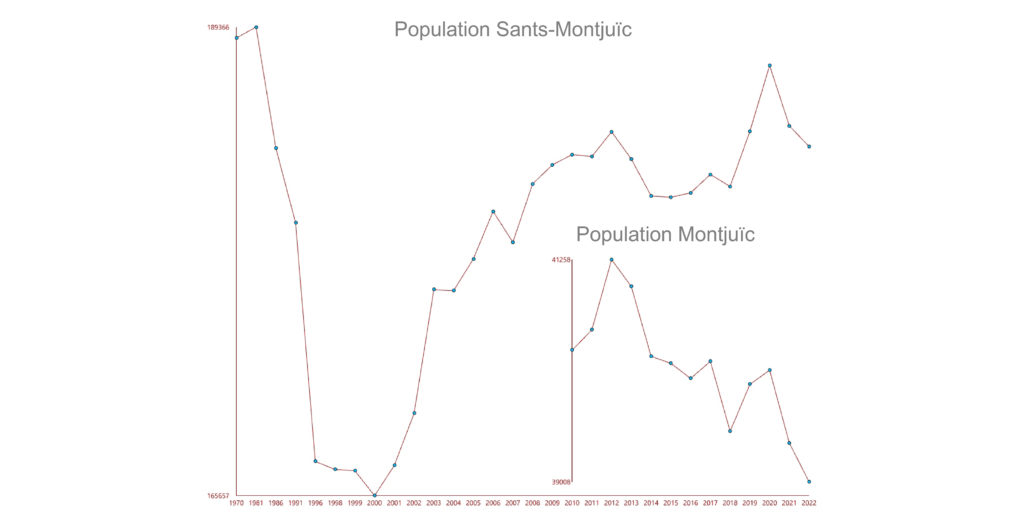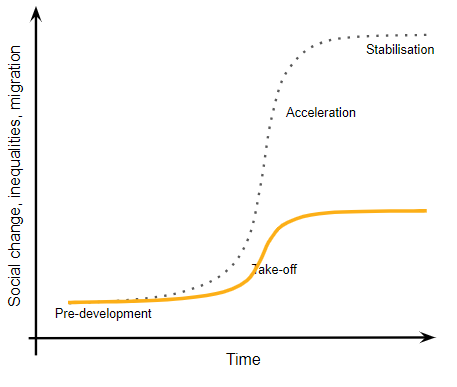The city of Barcelona has a history of change through impulses. No part of the city is more representative of this trend than Montjuïc. Throughout the 20th century, the area has undergone a number of spatial and social transformations which have typically occurred in short spaces of time. In this short study, we argue that each of these transformations can be related to technological developments in Montjuïc, Barcelona or even abroad. The question that we have chosen is the following:
How have technological innovations affected (spatial) inequality in Montjuïc?
We have approached this question using a theoretical framework that is linked tot the concept of the long 20th century.
A critical reading of the 20th century
Montjuïc has been a site of settlement since at least the Iberian period. Over the centuries, it has been the location of Jewish cemeteries, Roman ruins, and medieval fortresses. However, the area underwent radical development starting from the 20th century, beginning from the Barcelona International Exposition, 1929. This was later followed by the Olympic Games in Barcelona in 1992. In addition to the two major events in 1929 and 1992 we will also analyze two more recents moments: the 2008 financial crisis and the 2020 covid pandemic.
In his book “The long 20th century” Giovanni Arrighi defines the concept of capitalist cycles. In one cycle an economy transitions from an agrarian model, through an industrial model to a financial model of accumulation. According to Arrighi the transition inevitably ends in an over-abstraction of the economy and an ensuing financial crisis. Incidentally, the four events that we have focused on in this presentation coincide with the timespan Arreghi identifies as the long 20th century and are ended by a financial and medical crisis.
Migration as an indicator for inequality
The diagram below can be read in several ways. The two ways which are relevant for this analysis are, firstly as a way of understanding the development from a (pre)industrial economy to a financialized economy and secondly as a way to understand the effects of new innovations.
The implementations of new technologies compress space-time. In doing so they open up new markets for talent and competition from increasingly larger spheres. Consequently, local inequalities surge in a delayed ripple effect after every significant space-time compression.

1929 – International Exhibition
The 1929 International Exposition spurred the primary development in Montjuïc since its fortress’s inception, with the construction of various pavilions aligning Plaça Espanya. This significant investment introduced notable structures, including the Magic Fountain and steps to the Palau Nacional, elevating Montjuïc’s profile as a cultural destination introducing a regime of pleasure that changed the former ‘disreputable perception of the area’.
The funicular railway of Barcelona, opened in 1928 was one of the major technologies to make the mountain accessible for the fair. The trip up to the top now took 2 minutes compared to a 20 minute walk. The furincular was renovated following the exposition, once in 1992 for the Olympic Games and more recently in 2005, which gave it the modern appearance it has today.
The introduction of the funicular made the mountain accessible to a larger and wealthier public. The programme to change the appearance and accessibility of Montjuïc ahead of the exhibition resulted in the displacement of a large portion of the population living in informal housing. This happened either by force or by the steeply increasing housing price. The mountain had previously predominantly been inhabited by mineworkers from Galicia, who were now forced up to the higher altitudes of the mountain or dispersed across the peripheries of the city.

The yellow arrow follows the development from before to after the exhibition in three different ways: the change of the housing market, the rate of change, the spatial movement of people and spending power.
1992 – Olympic Games
The 1992 Olympics coincided with a major effort to reconnect the city with the sea. Montjuic was one of the areas where the city invested heavily. The incoming Olympics of 1992, demanded for Montjuïc to morph. Almost 35,000 people living in informal housing were displaced off the mountain. This movement led to the formation of a new housing settlement on the other side of the mountain.
One of the technologies that contributed to this development was the introduction of commercial airlines. Despite the fact that commercial airlines had already been in existence since the 1960s, the 1990s announced its arrival as a globally significant phenomenon. The price for the average flight had been reduced by 75% and now allowed large parts of the world population to travel increasingly larger distances.
The 1992 Olympics announced the arrival of mass tourism and immigration to Barcelona. It was a decisive moment in the history of the city since it was the first time after the dictatorship that the city made a large effort to promote itself as a hub for entertainment, consumption, trade and technological development. The arrival of new people raised the demand for housing and thereby drove the square meter prices up. In anticipation of opening up to the world, the city had also decided to clear out the remaining shanty towns on the mountain. The reframing of Montjuïc as an Olympic village thus formed a decisive step in the transformation of Montjuïc from a cluster for informal settlement to high end tourism accommodation hub.

Similarly to the displacements that took place in relation to the 1929 world exhibition, the displacements were founded on a combination of market forces as well as enforced displacements.
2008 – Global Financial Crisis
The 2008 financial crisis had a significant impact on Barcelona and the wider region of Catalonia. As one of the worst affected areas in Spain, Catalonia experienced a plunge in construction sales between June 2007 and June 2008. The crash can in part be attributed to the rise of automated trading systems and the increased housing speculations that this new technology made possible. These systems allowed the financial sector to significantly speed up its processes. The concept was developed throughout the second half of the 20th century and implemented on a large scale from the early 2000s onwards. Already early on there were warnings about the effect on market fragilities.
The large drop in the housing prices in the years following 2008 forced some people in Montjuïc to move to (temporary) smaller homes. As a result there was a brief spike in the population of the area. Small scale businesses in many cases did not survive the decrease in spending power which made Montjuïc (along with all of Spain) a less attractive destination for larger companies. Interestingly the dynamic for this recession demonstrates the opposite dynamics of the other events which revolved around growth.
2020 – COVID Pandemic
Spain was hit hard by the COVID pandemic. 121.760 people passed away and the country was put into lockdown several times, harming local businesses. During the pandemic, working remotely became normalized. Following the opening up of society a new type of citizen emerged: the digital nomad. The influx of remote workers from different parts of the world, created a market which replaced existing small scale businesses in the area. The spaces were taken over by bars, brunch spots and co-working spaces to reach the new customer base in Barcelona.
Spain’s Digital Nomad Visa was launched in 2022 post COVID as a part of the new Startup Act to attract non-EU nationals who work remotely for non-Spanish companies. Eligible applicants include self-employed freelancers and remote workers, who can stay for up to five years. The initiative typically aims to attract skilled workers and could influence urban demographics by increasing the number of international residents with the ability to contribute to the local economy and cultural diversity.
How can the transition curve be flattened?
From the different case studies we observe that the implementation of new technologies brings an unequal distribution of risk and benefits. The benefits and profits made from innovation accumulate with the groups that are directly involved with the new technology. It is important to redistribute the value that is created so that the transition curve is flattened and the social changes can be gradual and thereby more socially sustainable.
It is key that redistribution takes place on an economic as well as on a democratic field. One strategy to do so is the Social and Solidarity Economic Model (SSE). SSE focuses on the role of grassroots movements to anchor social changes in communities. According to SSE participation and local entrepreneurship are key elements in making redistribution socially sustainable.


